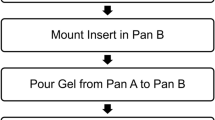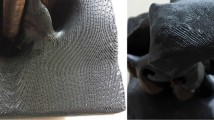Abstract
A one-dimensional (1D) numerical model has been previously developed to investigate the hemodynamics of blood flow in the entire human vascular network. In the current work, an experimental study of water–glycerin mixture flow in a 3D-printed silicone model of an anatomically accurate, complete circle of Willis (CoW) was conducted to investigate the flow characteristics in comparison with the simulated results by the 1D numerical model. In the experiment, the transient flow and pressure waveforms were measured at 13 selected segments within the flow network for comparisons. In the 1D simulation, the initial parameters of the vessel network were obtained by a direct measurement of the tubes in the experimental setup. The results verified that the 1D numerical model is able to capture the main features of the experimental pressure and flow waveforms with good reliability. The mean flow rates measurement results agree with the predictions of the 1D model with an overall difference of less than 1%. Further experiment might be needed to validate the 1D model in capturing pressure waveforms.








Similar content being viewed by others
References
Alastruey, J., A. W. Khir, K. S. Matthys, P. Segers, S. J. Sherwin, P. R. Verdonck, K. H. Parker, and J. Peiró. Pulse wave propagation in a model human arterial network: assessment of 1-D visco-elastic simulations against in vitro measurements. J. Biomech. 44(12):2250–2258, 2011.
Alastruey, J., K. H. Parker, J. Peiró, S. M. Byrd, and S. J. Sherwin. Modelling the circle of Willis to assess the effects of anatomical variations and occlusions on cerebral flows. J. Biomech. 40(8):1794–1805, 2007.
Alastruey, J., K. H. Parker, J. Peiró, and S. J. Sherwin. Lumped parameter outflow models for 1-D blood flow simulations: effect on pulse waves and parameter estimation. Commun. Comput. Phys. 4(2):317–336, 2008.
Alastruey, J., T. Passerini, L. Formaggia, and J. Peiró. Physical determining factors of the arterial pulse waveform: theoretical analysis and calculation using the 1-D formulation. J. Eng. Math. 77(1):19–37, 2012.
Blanco, P. J., and R. A. Feijóo. A dimensionally-heterogeneous closed-loop model for the cardiovascular system and its applications. Med. Eng. Phys. 35(5):652–667, 2013.
Boileau, E., P. Nithiarasu, P. J. Blanco, L. O. Müller, F. E. Fossan, L. R. Hellevik, W. P. Donders, W. Huberts, M. Willemet, and J. Alastruey. A benchmark study of numerical schemes for one-dimensional arterial blood flow modelling. Int. J. Numer. Method. Biomed. Eng. 31(10):e02732, 2015.
Cieslicki, K., and D. Ciesla. Investigations of flow and pressure distributions in physical model of the circle of Willis. J. Biomech. 38(11):2302–2310, 2005.
Danpinid, A., J. Luo, J. Vappou, P. Terdtoon, and E. E. Konofagou. In vivo characterization of the aortic wall stress–strain relationship. Ultrasonics 50(7):654–665, 2010.
DeVault, K., P. A. Gremaud, V. Novak, M. S. Olufsen, G. Vernieres, and P. Zhao. Blood flow in the circle of Willis: modeling and calibration. Multisc. Model. Simul. 7(2):888–909, 2008.
Fahy, P., P. McCarthy, S. Sultan, N. Hynes, P. Delassus, and L. Morris. An experimental investigation of the hemodynamic variations due to aplastic vessels within three-dimensional phantom models of the circle of Willis. Ann. Biomed. Eng. 42(1):123–138, 2014.
Formaggia, L., J. F. Gerbeau, F. Nobile, and A. Quarteroni. On the coupling of 3D and 1D Navier–Stokes equations for flow problems in compliant vessels. Comput. Methods Appl. Mech. Eng. 191(6–7):561–582, 2001.
Ghigo, A. R., X. Wang, R. Armentano, J. M. Fullana, and P. Y. Lagrée. Linear and nonlinear viscoelastic arterial wall models: application on animals. J. Biomech. Eng. 139(1):011003, 2017.
Grinberg, L., T. Anor, E. Cheever, J. R. Madsen, and G. E. Karniadakis. Simulation of the human intracranial arterial tree. Philos. Trans. A Math. Phys. Eng. Sci. 367(1896):2371–2386, 2009.
Grinberg, L., E. Cheever, T. Anor, J. R. Madsen, and G. E. Karniadakis. Modeling blood flow circulation in intracranial arterial networks: a comparative 3D/1D simulation study. Ann. Biomed. Eng. 39(1):297–309, 2011.
Hendrikse, J., A. F. Raamt, Y. Graaf, W. P. Mali, and J. Grond. Distribution of cerebral blood flow in the circle of Willis. Radiology 235(1):184–189, 2005.
Huang, P. G., and L. O. Muller. Simulation of one-dimensional blood flow in networks of human vessels using a novel TVD scheme. Int. J. Numer. Method. Biomed. Eng. 31(5):e02701, 2015.
Huang, G. P., H. Yu, Z. Yang, R. Schwieterman, and B. Ludwig. 1D simulation of blood flow characteristics in the circle of Willis using THINkS. Comput. Methods Biomech. Biomed. Eng. 21(4):389–397, 2018.
Kim, C. S., C. Kiris, D. Kwak, and T. David. Numerical simulation of local blood flow in the carotid and cerebral arteries under altered gravity. J. Biomech. Eng. 128(2):194–202, 2006.
Liang, F., K. Fukasaku, H. Liu, and S. Takagi. A computational model study of the influence of the anatomy of the circle of Willis on cerebral hyperperfusion following carotid artery surgery. Biomed. Eng. online 10(1):84, 2011.
Liang, F., S. Takagi, R. Himeno, and H. Liu. Biomechanical characterization of ventricular–arterial coupling during aging: a multi-scale model study. J. Biomech. 42(6):692–704, 2009.
Liu, Y., C. Dang, M. Garcia, H. Gregersen, and G. S. Kassab. Surrounding tissues affect the passive mechanics of the vessel wall: theory and experiment. Am. J. Physiol. Heart. Circ. Physiol. 293(6):H3290–H3300, 2007.
Matthys, K. S., J. Alastruey, J. Peiró, A. W. Khir, P. Segers, P. R. Verdonck, K. H. Parker, and S. J. Sherwin. Pulse wave propagation in a model human arterial network: assessment of 1-D numerical simulations against in vitro measurements. J. Biomech. 40(15):3476–3486, 2007.
Misra, J. C., and S. I. Singh. A large deformation analysis for aortic walls under a physiological loading. Int. J. Eng. Sci. 21(10):1193–1202, 1983.
Moireau, P., N. Xiao, M. Astorino, C. A. Figueroa, D. Chapelle, C. A. Taylor, and J. F. Gerbeau. External tissue support and fluid–structure simulation in blood flows. Biomech. Model. Mechanobiol. 11(1–2):1–18, 2012.
Mukherjee, D., N. D. Jani, J. Narvid, and S. C. Shadden. The role of circle of Willis anatomy variations in cardio-embolic stroke: a patient-specific simulation based study. Ann. Biomed. Eng. 46(8):1128–1145, 2018.
Müller, L. O., and E. F. Toro. A global multiscale mathematical model for the human circulation with emphasis on the venous system. Int. J. Numer. Method. Biomed. Eng. 30(7):681–725, 2014.
Mynard, J. P., and J. J. Smolich. One-dimensional haemodynamic modeling and wave dynamics in the entire adult circulation. Ann. Biomed. Eng. 43(6):1443–1460, 2015.
Raghu, R., I. E. Vignon-Clementel, A. C. Figueroa, and C. A. Taylor. Comparative study of viscoelastic arterial wall models in nonlinear one-dimensional finite element simulations of blood flow. J. Biomech. Eng. 133(8):081003, 2011.
Reymond, P., Y. Bohraus, F. Perren, F. Lazeyras, and N. Stergiopulos. Validation of a patient-specific one-dimensional model of the systemic arterial tree. Am. J. Physiol. Heart Circ. Physiol. 30(3):H1173–H1182, 2011.
Reymond, P., F. Merenda, F. Perren, D. Rufenacht, and N. Stergiopulos. Validation of a one-dimensional model of the systemic arterial tree. Am. J. Physiol. Heart Circ. Physiol. 297(1):H208–H222, 2009.
Xu, L., F. Liang, B. Zhao, J. Wan, and H. Liu. Influence of aging-induced flow waveform variation on hemodynamics in aneurysms present at the internal carotid artery: a computational model-based study. Comput. Biol. Med. 101:51–60, 2018.
Yang, Z., H. Yu, G. P. Huang, R. Schwieterman, and B. Ludwig. Computational fluid dynamics simulation of intracranial aneurysms–comparing size and shape. J. Coast. Life Med. 3(3):245–252, 2015.
Yu, H., G. P. Huang, Z. Yang, F. Liang, and B. Ludwig. The influence of normal and early vascular aging on hemodynamic characteristics in cardio-and cerebrovascular systems. J. Biomech. Eng. 138(6):061002, 2016.
Yu, H., G. P. Huang, Z. Yang, and B. R. Ludwig. A multiscale computational modeling for cerebral blood flow with aneurysms and/or stenoses. Int. J. Numer. Method. Biomed. Eng. 34(10):3127, 2018.
Zhang, H., N. Fujiwara, M. Kobayashi, S. Yamada, F. Liang, S. Takagi, and M. Oshima. Development of a numerical method for patient-specific cerebral circulation using 1d–0d simulation of the entire cardiovascular system with SPECT data. Ann. Biomed. Eng. 44(8):2351–2363, 2016.
Zhang, W., C. Herrera, S. N. Atluri, and G. S. Kassab. Effect of surrounding tissue on vessel fluid and solid mechanics. J. Biomech. Eng. 126(6):760–769, 2004.
Acknowledgments
The authors would like to acknowledge the Translational Research Development Grants from the Office of Research Affairs at Wright State University.
Conflict of interest
There are no conflicts of interest that could inappropriately influence this research work.
Author information
Authors and Affiliations
Corresponding author
Additional information
Associate Editor Ender A. Finol oversaw the review of this article.
Publisher's Note
Springer Nature remains neutral with regard to jurisdictional claims in published maps and institutional affiliations.
Appendices
Appendix 1: The Measurement of the Viscosity of the Working Fluid
To measure the viscosity of the working fluid, a falling sphere method was used. The relationship between the viscosity of the working fluid and the terminal velocity of the sphere can be determined as \(\mu = 2gr_{\text{s}}^{2} (\rho_{\text{s}} - \rho_{\text{l}} )/9u_{\text{t}}\), where \(\mu\) is the viscosity of the working fluid, \(g\) is acceleration due to gravity (a fixed value of 9.8 m s−2), \(r_{\text{s}}\) is the radius of the sphere, \(\rho_{\text{s}}\) is the density of the sphere, \(\rho_{\text{l}}\) is the density of the working fluid, and \(u_{\text{t}}\) is the velocity of the sphere. Briefly, in a graduated cylinder, a sphere was allowed to fall between a certain distance with marked positions at the top and bottom through the working fluid. A stopwatch was used to record the time during the sphere falling through the marked distance and its velocity was determined. The density of the sphere and working fluid was measured by dividing the mass by the volume. With having all the parameter values, the viscosity of the working fluid can be computed by the above equation.
Appendix 2: Phase-Averaging Method
The 150 measurements were split into individual waveforms by defining a reference point to distinguish each complete cardiac cycle. The reference point was chosen at the middle point of the rising edge of waveform to ensure the accuracy of the alignment of waveforms, because less fluctuation was observed in this region. The time scale for each waveform was normalized by dividing by its time interval for phase-based averaging. For pressure curves, the individual pressure waveform was end-diastolic aligned in the time domain for averaging.
Rights and permissions
About this article
Cite this article
Yu, H., Huang, G.P., Ludwig, B.R. et al. An In-Vitro Flow Study Using an Artificial Circle of Willis Model for Validation of an Existing One-Dimensional Numerical Model. Ann Biomed Eng 47, 1023–1037 (2019). https://doi.org/10.1007/s10439-019-02211-6
Received:
Accepted:
Published:
Issue Date:
DOI: https://doi.org/10.1007/s10439-019-02211-6




